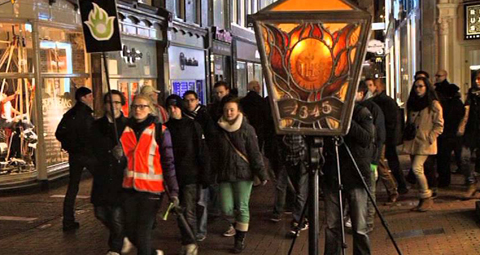March 23 | ![]() 0 COMMENTS
0 COMMENTS ![]() print
print

Time to go Dutch, or why Holland’s cool for Catholics
In the latest of his regular series, ROSS AHLFELD reveals how, despite its Calvinist traditions and struggles with decadent consumerism, there is much to take comfort in during a visit to Amsterdam, the Netherlands, and a little-known seaside resort— By ROSS AHLFELD
As we continue on our journey through Lent, our thoughts turn to fasting and abstinence. But, to be honest, I’m not really known for my cookery skills nor do I have much interest in the current love affair with celebrity chefs or those ‘foodie’ types with massive mock-rustic kitchens. My idea of a quality tea is fish fingers, beans, chips and buttered bread washed down with arctic roll for pudding and a large glass of milk.
As my mates like to tell me: “Ross, you have the culinary tastes of a 1970s toddler.”
Most of all, I dislike the modern notion that having an interest in food somehow makes you more cultured or interesting. As if a liking for spaghetti bolognese somehow causes you to be intimate with the films of Federico Fellini or the music of Giuseppe Verdi.
Having said all that, the one food which I do eat plenty of is fish, particularly smoked and pickled herring, especially on a Friday as part of my weekly abstinence.
With the consumption of herring comes an authentic, cultural and historic tradition which you won’t find being propagated by food hipsters and gastro-bores. The difference between herring culture and the pseudo-gourmet guff is to be found in the fact that the tradition of catching and eating herring is firmly rooted in the cultural life of Northern European Catholicism.
It’s also worth contrasting the histrionics from the likes of Gordon Ramsay and Marco Pierre White with the dignified and stoic conduct of our own trawlermen risking their lives on the high seas.
Indeed, smoked herring—kippers—were once widely enjoyed by most of Scotland’s urban and rural working classes before the war and, here on the Firth of Clyde, herring was once so plentiful that fishing boats sailed from as far as the Isle of Man to share in the catch.
I’ve also been told that generations of local herring fishermen would use mussels to bait their lines and then discard the shells and it’s these which eventually formed a distinctive blue-black embankment all along the Gourock shoreline. It is also thought that the first ‘Red Herring’ ever cured in Britain was cured at Gourock in 1688. As such, perhaps it would be a good idea to restore the Friday fast and get back to eating the good old herring.
Even today, herring is still a hugely popular delicacy in north Germany, the Netherlands and Flanders. This is due to the influence of the Hanseatic League and their long association with herring fishing. The League was created in the 12th century by an alliance between the cities of Hamburg and Lubeck, and some of their merchants ended up in Scotland.
William Wallace even wrote a famous letter to the Hanseatic merchants of Lubeck, inviting them to trade. Interestingly, some of the aforementioned east coast trawlerfolk are generally supposed to be of Flemish and Dutch descent.
Nonetheless, Lubeck’s fishermen had easy access to the herring spawning grounds off the Baltic coast of Sweden. A big part of the diet of Northern European Catholics at this time was made up of herring since abstinence from meat on Fridays and also on the other fast days was dutifully observed.
As such, the Lubeckers were in a strong position to capitalise on the herring market. Meanwhile, nearby Hamburg had easy access to the salt mines at Kiel, and salting and drying of fish made transport possible. Today, there are many different variations of herring which are popular in the Netherlands and Northern Germany, such as Dutch soused herring and rollmops.
Yet, it’s not just a love of herring, beer or the wide North Sea coastline which we share with the Flemish, Dutch and Germans. Like our own Scalan Seminary hidden in the Braes of Glenlivet, Dutch Catholics also have their hidden places of pilgrimage and devotion.
For example, the Netherlands and especially Amsterdam probably aren’t among the top destinations Catholics think of when considering where to go on pilgrimage. This is mainly due to the fact that the county of Holland is mostly Calvinist and ultra-liberal, while Amsterdam is considered to be (as my grandparents used to say) ‘a den of iniquity.’
More so, the Church in the Netherlands isn’t exactly thriving and nor does it have its problems to seek. Yet, all is not what it seems in the Netherlands, especially since this apparently irreligious country has something we Scots do not possess: A Bible Belt or ‘Bibelgordel,’ as the Dutch say.
One of the places within the Dutch Bible Belt, which I love to visit, is the town of Katwijk. It is a small, close-knit seaside town and former North Sea fishing village, where the locals are very religious, conservative and also consume copious amounts of herring.
You could say Katwijk is a wee bit like Gourock (except with tall people). And like Gourock, Katwijk is no longer a popular tourist destination but is quiet and relaxing, where you can spend hours walking or cycling out in the sand dunes. Despite it being conservative and strictly Calvinist, Katwijk has always been warmly welcoming to me. It is both a timeless and fascinating place, and a sharp contrast to the decadence of Amsterdam.
Even so, you might well ask: what do these Dutch Reformed regions have to do with us Catholics? Well, I guess there are a few different answers to that question. First, the presence of Catholic voices in Dutch public life is the story of a close relationship with the Calvinist community. For all Dutch Christians, being ecumenical has become a necessity. For example, the south Netherlands has always been traditionally Catholic while the north is Calvinist.
Historically, Dutch Christians lived under a ‘pillar system’ which meant that each group lived apart, leaving each other alone to their own affairs.
But in the 1980s Catholics and Protestants came together to form a united political party called Christian Democratic Appeal, which has participated in all but three governments since its foundation.
As such, the Christian Democratic political tradition in the Netherlands has managed to produce a series of popular Catholic politicians and numerous Catholic Prime Ministers such as Piet de Jong, Dries Van Agt, Ruud Lubbers, Joseph Luns and Marga Klompé and walks in the footsteps of modern Catholic saints such as Titus Brandsma, the Dutch Carmelite who died in Dachau concentration camp and Fr Werenfried van Straaten, the ‘Bacon Priest’ who fed thousands of starving German refugees after the Second World War and founded Aid to the Church in Need.
However, the famous Dutch tolerance enjoyed by Catholics in the Netherlands today wasn’t always the norm. Historically, Catholics in cities such as Amsterdam faced persecution and discrimination for many decades following the Reformation. One of the consequences this persecution was the development of a very unusual Catholic pilgrimage custom in Amsterdam called ‘Stille Omgang’ (Silent Walk).
According to tradition, in the year 1345, a man lay ill in his home on the Kalverstraat. Apparently, he thought he was just about to die and so he asked for the priest to administer Viaticum as part of the Last Rites. After receiving the Blessed Sacrament, the man was sick and vomited.
As was the custom in the Netherlands at the time, what he had brought up was thrown on the fire. The following morning, the Host was found to be completely undamaged in the ashes of the fire.
Other miracles then came to be associated with this Host and so began the great tradition known as the Miracle Procession, and a few years later a chapel was built on the site of the miracles.
Eventually, Amsterdam became a key pilgrimage site for pilgrims from all over Northern Europe who came to take part in its magnificent Eucharistic Procession.
However, in 1578 Amsterdam’s ruling authorities converted to Calvinism and the Holy Mass was forbidden and only ever said in clandestine house churches. But the procession of the Miracle was so important to Amsterdam’s Catholics, that, during the 17th and 18th centuries, the faithful still managed to find ways to continue the annual walk and veneration on a smaller scale, entirely in secret.
The tradition was continued by a small group in the secret church in the Beguinage and individuals silently continued to walk the route previously taken by the Procession for centuries.
Dutch Catholics were finally emancipated in the 19th century and the full restoration of the ‘Stille Omgang’ began in 1881.
Today, thousands of Catholics from all over the Netherlands take part every year.
People walk, cycle or come by bus or car to Amsterdam to join in the procession, which climaxes with Mass in one of the parish churches of the city. Every year a different special intention is chosen as the theme but Christ’s presence in the Eucharist and the penitential nature of Lent is always at the heart of this event. As well as passing through ‘The Dam’s’ more seedy and notorious areas, this ancient route also passes by several important Catholic places along the way, such as the hidden Catholic church Ons’ Lieve Heer op Solder.
Each year, the festival week starts with a series of Masses and other events on the first Wednesday after March 12, running from the Wednesday through to the Saturday. The Procession then begins on Saturday night, continuing late into Sunday morning. The pilgrims gather in the centre of Amsterdam and later take part in the Silent Procession at different times during the night, following the route.
The most striking thing you immediately notice about this pilgrimage is the fact that it is done entirely in silence, without spoken prayers or hymns. It normally takes about an hour to complete and should be walked between midnight and four o’clock on Sunday morning.
All this talk of Christian Democracy, beer, fish, canals, windmills, bulbs, pretty coastal villages and hidden chapels offers a warm and cosy picture of belonging to a nice Dutch Catholicism rooted in the Brethren of the Common Life, Beguines and Beghards.
However, the city of Leiden offers a stark reminder to all Christians, both Catholic and Protestant, that ultimately, we Christians have no homeland we can truly call our own. Instead, our identity is always to be found in Christ and in Christ alone.
The Pieterskerk in Leiden was the church of the Pilgrim Fathers while they were based in the Netherlands before sailing on the Mayflower to the New World.
Leiden was also home to the Scots Presbyterian community during the Restoration period. A commemorative plaque to the Pilgrim Fathers in the Pieterskerk reads, ‘But now we are all, in all places, strangers and pilgrims, travellers and sojourners.’
Visiting this place and seeing this statement in Leiden taught me the very essence of what it means to be a pilgrim.
It also reminded me that we Christians are never fully under civic authority or integrated into the secular nation-state.
As much as I love visiting beautiful Dutch cities such as Delft, The Hague and Maastricht, in truth, all Christian communities are always resident aliens, called to be a people set apart, wherever we find ourselves in the world.
And so, perhaps the political alliance between the Dutch Calvinists in the Bible Belt and the Catholics in south Netherlands has much to teach us about how we deal with the rising tide of militant secularism in Scotland. Or maybe we could go to Amsterdam as pilgrims and walk the route of the silent procession and experience how a hidden Catholic community learned to survive during a time of persecution. Perchance, as a preparation for the future, for all we know?











